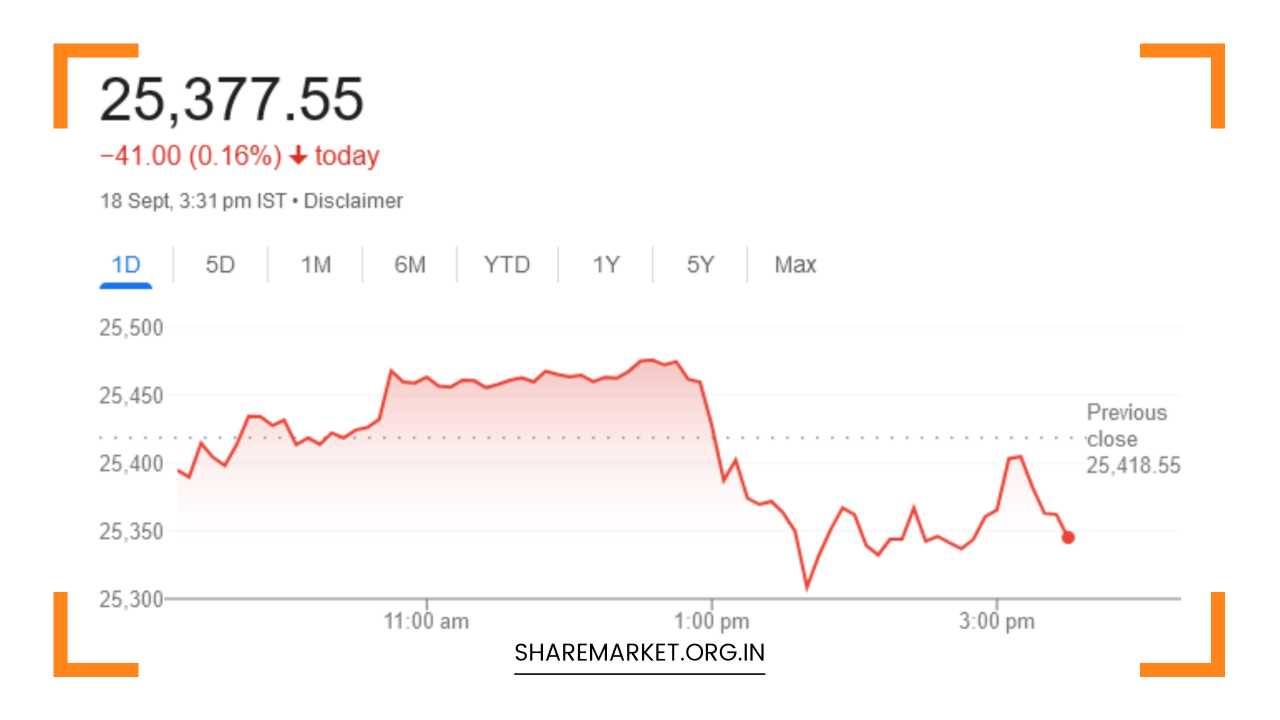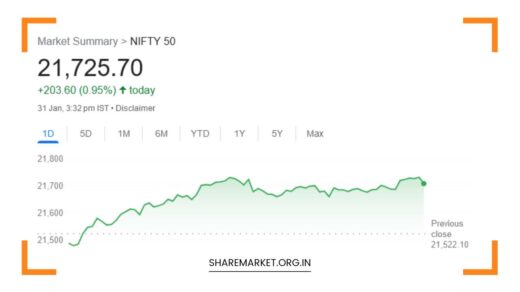Sensex Down 131 Points, Nifty at 25,377; Tomorrow Nifty Prediction

Tomorrow Nifty Prediction
Sensex-Nifty Close Lower: What to Expect on September 19
The trading session on September 18 saw both the Sensex and Nifty indices close lower, reflecting a cautious market sentiment as investors awaited the Federal Reserve’s decision on interest rates.
The Nifty has recently been moving within a narrow range, showcasing a mixture of bullish and bearish signals.
Key support for the index is positioned at 25,300; if this level is breached, it could pave the way for a further decline towards the 24,900-25,000 range.
On the upside, the market faces resistance at 25,580, making upward momentum challenging in the short term.
Market Dynamics
Today’s trading was marked by notable volatility, with market participants adopting a wait-and-see approach in anticipation of the Fed’s outcome.
The Sensex closed down 131 points at 82,948, while the Nifty fell by 41 points to end at 25,378. This decline was particularly pronounced in midcap and smallcap stocks, which have shown vulnerability recently.
In contrast, the Nifty Bank index closed positively, up 562 points at 52,750, providing some support to the broader market.
A deeper look into sector performance reveals a mixed bag. Stocks in the IT, pharma, metal, and oil-gas sectors faced significant selling pressure, which contributed to the overall market decline.
Additionally, there was notable weakness in energy, public sector enterprises (PSEs), and infrastructure stocks.
Ultimately, 19 out of 30 Sensex stocks registered losses, and 30 out of 50 Nifty stocks showed weakness, highlighting the challenging environment for investors.
Technical Analysis and Expert Insights
Aditya Gaggar, Director at Progressive Shares, noted that the rally led by banking stocks had previously helped the Nifty achieve a new high of 25,482.
However, the declines in mid and smallcap stocks exerted downward pressure on the index. A late-session recovery managed to mitigate some losses, but the overall tone remained negative.
Gaggar emphasized the importance of being aware of key support and resistance levels, with Nifty currently facing resistance at 25,580 and support at 25,300.
According to Sameet Chavan, Head of Technical and Derivative Research at Angel One, the market appears to be adopting a cautious stance as it approaches the FOMC announcement.
He advised traders to be vigilant, avoiding both complacency and aggressive positions during this volatile period. Chavan’s insights underscore the need for strategic planning in the face of potential market fluctuations.
Vikram Kasat from PL Capital (Prabhudas Lilladher) elaborated on the tensions surrounding the Fed’s decision-making process.
He highlighted that the central bank is currently weighing options between a quarter-point or half-point interest rate cut.
Kasat pointed out that while a rate cut may provide some short-term relief, it is not a comprehensive solution for borrowers grappling with high borrowing costs.
He stressed that only a series of rate cuts over time would yield significant benefits for households, indicating that traders should remain cautious in their expectations.
Profit Booking and Market Reactions
Rupak Dey of LKP Securities remarked on the recent peaks achieved by the Nifty prior to the Federal Reserve’s announcement on interest rates.
He observed that many traders engaged in profit booking at elevated levels, leading to a closure approximately 130 points below the day’s peak.
This behavior reflects a broader market trend, where traders may be hesitant to hold positions amid uncertainty, resulting in short-term declines.
The Nifty’s recent performance highlights its struggle to maintain upward momentum. The index has oscillated within a confined range, with support at 25,300 being crucial for its stability.
If this level is breached, the market could experience further selling pressure, potentially dragging it down toward the 24,900-25,000 range.
On the flip side, resistance at 25,500 suggests that the market may face challenges in breaking through this level in the near term.
Investor Sentiment and Future Outlook
As the market grapples with the implications of the Fed’s impending decision, investor sentiment is a vital component to consider.
The anticipation of interest rate adjustments can lead to increased volatility, affecting trading patterns and investment strategies.
Investors are advised to monitor economic indicators closely, as these can provide valuable insights into market trends and help them make informed decisions.
In the context of global markets, the Fed’s actions are not just significant for the U.S. economy but can also influence investor behavior worldwide.
A rate cut could signal a shift in monetary policy aimed at stimulating growth, which may benefit certain sectors, particularly those sensitive to borrowing costs.
Conversely, a decision to maintain or increase rates could heighten concerns about economic stability and lead to further market corrections.
Final Remarks
In conclusion, the current market landscape is characterized by uncertainty and caution as traders await the Federal Reserve’s interest rate decision.
With the Nifty experiencing a mix of support and resistance levels, market participants should remain vigilant and adaptable.
The interplay between banking stocks and broader market dynamics will be crucial in shaping the trading environment.
As we approach September 19, the market is likely to experience heightened fluctuations, making it essential for investors to employ strategic approaches to navigate this volatile period effectively.
By keeping an eye on key support and resistance levels, along with global economic indicators, traders can better position themselves in an ever-changing market landscape.

















